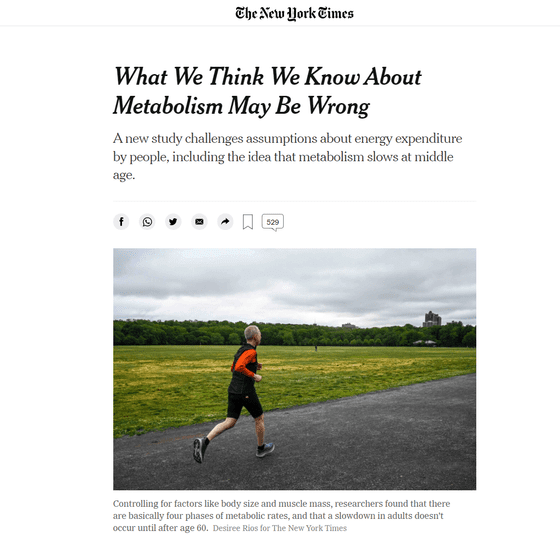'Middle-aged people have less metabolism than young people, so they get fat' may be a mistake, and research results show that energy consumption is almost unchanged from 20s to 60s.

Many of the people who couldn't wear their old clothes because they got fat should have lamented, 'I didn't get fat no matter what I ate when I was young.' It is sometimes said that 'young people are active in metabolism, and in middle and old age, their metabolism drops, so they get fat.' Contrary to such a general image, 'energy consumption is consumed by both young people in their 20s and people in their 60s.' 'It's almost the same,' the research results were announced by researchers at Duke University in the United States.
Daily energy expenditure through the human life course
Metabolism Changes With Age, Just Not When You Might Think | Duke Today
https://today.duke.edu/2021/08/metabolism-changes-age-just-not-when-you-might-think
Metabolism Changes With Age – But Exactly When Is Quite Surprising
https://scitechdaily.com/metabolism-changes-with-age-but-exactly-when-is-quite-surprising/
What We Think We Know About Metabolism May Be Wrong --The New York Times
https://www.nytimes.com/2021/08/12/health/metabolism-weight-aging.html

Studies on changes in metabolism with aging have been conducted so far, but most of these studies
Therefore, a research team of Duke University researchers Herman Pontzer and others used a method called 'double-labeled water method ' to investigate the total energy consumption of people of all ages per day. I did it.
The double-labeled water method is a measurement method that uses stable isotopes of hydrogen and oxygen, which are constituents of water. Most of the hydrogen that makes up normal water has a mass number of 1 and oxygen is 16, whereas the water that the subject drinks with this method is deuterium with a mass number of 2 and oxygen with a mass number of 18. Contains a lot of 18. Double-labeled water mixes evenly with normal water in the body, but people with high activity use a lot of oxygen, so the concentration of oxygen-18 quickly diminishes. Using this principle, the total consumption including the energy consumed by the activity is calculated, so the double-labeled water method is said to be the best method for investigating the total daily energy consumption.
When Pontzer et al. Used the double-labeled water method to examine the energy consumption of 6,600 people aged 1 week to 95 years old living in 29 countries around the world, calories burned in the age group of 20 to 60 years old. It turned out to be almost flat.
'It's a very important treatise, and I'm sure it will appear in textbooks,' said Lian Redman of the Pennington Biomedical Institute in the United States, who was asked to comment on the findings by the New York Times.
The study also found that human metabolism can be divided into four stages in a lifetime:
1. 1. Energy consumption has skyrocketed since infancy, reaching more than 50% of adults by the time they reach their first birthday.
2. From 1 to 20 years old, metabolism decreases by about 3% per year.
3. Metabolic changes are stable from 20 to 60 years.
4. After the age of 60, metabolism decreases by about 0.7% per year.
In addition, it has been thought that women have less metabolism than men, but as a result of correcting their physique and muscle mass, it has been found that there is no difference between men and women.

What surprised Mr. Pontzer in particular was that by the age of one he was consuming half the calories of an adult. Regarding this result, he said, 'Of course, there should be some energy that can be devoted to growth, but even with that in mind, the increase in energy consumption expected from body size and body composition was more than expected. In the baby's cells. There seems to be something happening that makes the metabolism more active, but we still don't know what it is. '
Ponzer also commented that adolescent teenagers thought they would burn more calories, but it was also unexpected that they didn't see that change.
The study, which reveals changes in human development and age-related metabolism, says the research team will be able to better manage drug dosages and age-appropriate health care for children and the elderly. doing.
Related Posts:
in Science, Posted by log1l_ks







